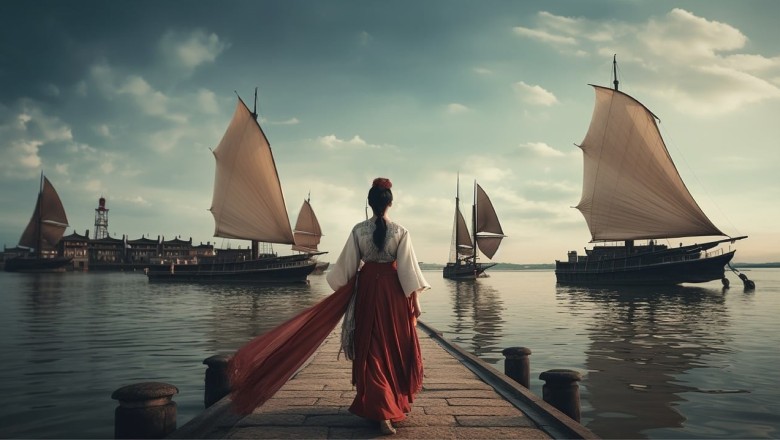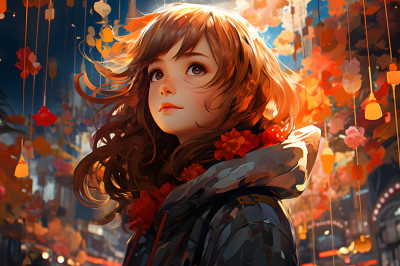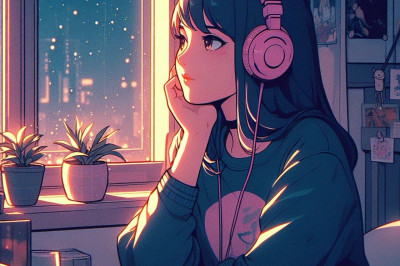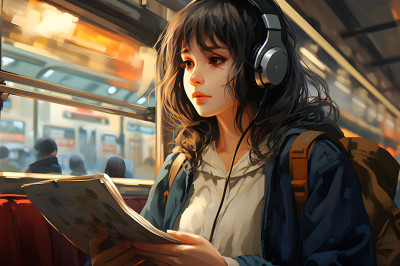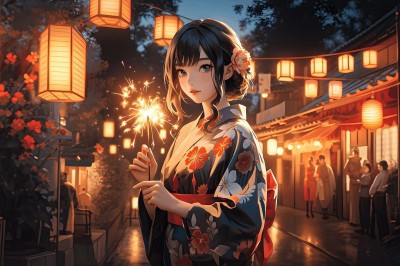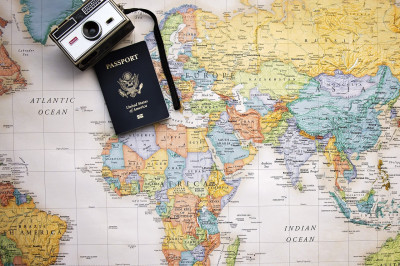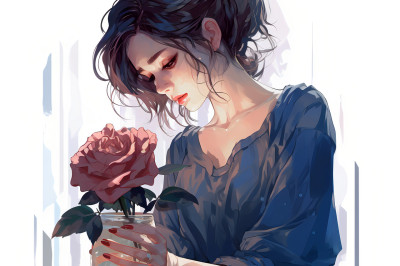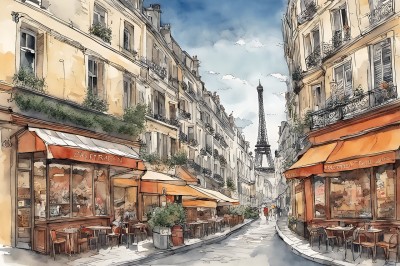The Anime Effect: Exploring Its Pervasive Role in International Pop CultureIntroduction to Anime and Its Origins
Anime, a term derived from the English word 'animation', refers to a distinctive style of animated media that originated in Japan. It encompasses a wide range of genres and caters to various audiences, from children to adults. Anime is characterized by its colorful artwork, fantastical themes, and vibrant characters, which often possess exaggerated facial expressions and eye sizes.
The Birth of Anime
The origins of anime can be traced back to the early 20th century. The earliest known Japanese animation dates from 1917, with works such as "Namakura Gatana" (The Dull Sword) and "Katsudō Shashin" (Moving Picture). These silent short films were heavily influenced by Western animation and the burgeoning film industry.
The Influence of Western Animation
During the 1920s and 1930s, Western animation from studios like Disney began to make its way to Japan, inspiring local animators and filmmakers. This influence is evident in the style and storytelling techniques that were adopted and adapted by Japanese artists. The fusion of Western methods with traditional Japanese art created a unique blend that laid the groundwork for modern anime.
The Post-War Era and Tezuka Osamu
The post-World War II era marked a significant turning point for Japanese animation. Economic constraints and a scarcity of resources led to the development of cost-effective production techniques. It was during this time that Tezuka Osamu, often referred to as the "God of Manga", made his mark. His work on the seminal series "Astro Boy" (Tetsuwan Atomu) in 1963 introduced many elements that would become standard in anime, including the serialized format and the iconic large eyes characteristic of anime characters.
The Evolution of Anime in the 1970s and 1980s
The 1970s and 1980s saw the diversification of anime, with genres expanding to include mecha, science fiction, and space operas. Series like "Mobile Suit Gundam" revolutionized the mecha genre by introducing complex storylines and deeper character development. The success of these series led to anime becoming a major cultural export for Japan.
The Rise of Anime Studios and Influential Creators
As the popularity of anime grew, so did the number of studios producing it. Studios such as Toei Animation, Madhouse, and Studio Ghibli became household names, each with their own distinctive style and storytelling approach. Influential creators like Hayao Miyazaki and Mamoru Oshii pushed the boundaries of the medium, creating films that garnered international acclaim and influenced a generation of animators worldwide.
The Globalization of Anime
The late 20th and early 21st centuries marked the globalization of anime, with shows like "Dragon Ball Z", "Sailor Moon", and "Pokémon" becoming massive hits internationally. The advent of the internet and digital streaming services further accelerated the spread of anime, making it easily accessible to audiences all over the world. This global reach has led to anime conventions, collaborations with international artists, and a significant impact on global pop culture.
Technological Advancements and Modern Anime
Technological advancements have also played a role in the evolution of anime. The transition from hand-drawn cel animation to digital processes has allowed for more intricate designs and fluid animation. Modern anime continues to innovate, with new techniques in CGI and interactive media expanding the possibilities of the genre.
Through its rich history and continuous evolution, anime has established itself as a significant cultural force with a profound influence on international pop culture. From its early silent films to the diverse and technologically advanced productions of today, anime's origins have set the stage for its pervasive role in global entertainment.
The Rise of Anime: From Niche to MainstreamEarly Beginnings and Cultural Exchange
Anime, a distinctive style of animation that originated in Japan, began its journey in the early 20th century. However, it wasn't until the post-World War II era that anime started to develop its unique characteristics, influenced by both Eastern and Western animation styles. Early works such as "Astro Boy" (Tetsuwan Atomu), created by Osamu Tezuka in the 1960s, marked the beginning of anime as a cultural export, though its audience was still relatively limited outside of Japan.
Breakthrough Titles and International Broadcasting
The international breakthrough for anime came in the 1970s and 1980s with titles like "Mobile Suit Gundam," "Space Battleship Yamato," and "Dragon Ball." These series captured the imagination of viewers around the world, leading to increased broadcasting of anime outside Japan. The success of these shows paved the way for anime to be recognized as a versatile medium capable of telling a wide range of stories, from science fiction to fantasy to romance.
The Role of Home Video and Fandom
The rise of the home video market in the 1980s and 1990s played a crucial role in anime's journey to mainstream popularity. Fans could now collect and trade VHS tapes, often fan-subtitled, which allowed for the spread of anime beyond the constraints of traditional broadcasting. This period also saw the emergence of anime conventions, fanzines, and clubs, creating a strong community of enthusiasts who championed the medium.
Digital Revolution and Online Communities
With the advent of the internet and digital streaming platforms in the late 1990s and early 2000s, anime found a new and rapidly expanding audience. Online forums and websites facilitated fan discussions, fan art, and fan fiction, further solidifying anime's presence in international pop culture. The ease of access to anime content online contributed significantly to its growth in popularity.
Mainstream Media Recognition and Box Office Success
Anime began to receive significant recognition in mainstream media with the international success of films like "Spirited Away" by Hayao Miyazaki, which won the Academy Award for Best Animated Feature in The critical acclaim and box office success of such films introduced anime to a broader audience and demonstrated its artistic merit to skeptics.
Influence on Western Animation and Entertainment
Western animation studios and creators have openly acknowledged the influence of anime on their work. The visual style, storytelling techniques, and character development found in anime have inspired a new generation of animators and storytellers in the West. This cross-cultural exchange has led to the creation of works that blend elements of both anime and Western animation, further integrating anime into the global pop culture lexicon.
The Role of Merchandising and Cross-Media Expansion
Merchandising has also played a significant role in anime's rise to mainstream status. The availability of anime-related products, from action figures to clothing to video games, has made the medium a staple in the global market. Additionally, the expansion of anime into other media, such as light novels, manga, and live-action films, has created a multi-platform presence that engages fans across various forms of entertainment.
Streaming Services and the Era of Accessibility
The proliferation of streaming services like Netflix, Crunchyroll, and Amazon Prime has made anime more accessible than ever before. These platforms offer extensive libraries of anime titles, ranging from classic series to the latest releases, often with professional subtitles or dubs in multiple languages. This ease of access has contributed to anime's sustained popularity and growth, allowing it to reach a diverse, global audience.
The Global Anime Community and Cultural Impact
Anime's rise to mainstream prominence has fostered a global community of fans who share a passion for the medium. This community transcends geographical and cultural boundaries, with anime conventions, cosplay events, and fan meetups occurring worldwide. The cultural impact of anime is evident in its influence on fashion, music, art, and literature, showcasing its pervasive role in international pop culture.
Anime's Influence on Western Animation and FilmVisual Style and Aesthetics
Anime has had a significant impact on the visual style of Western animation. The distinct anime characteristics, such as large expressive eyes, exaggerated facial expressions, and dynamic motion, have been adopted by Western animators to varying degrees. Shows like "Avatar: The Last Airbender" and its sequel "The Legend of Korra" are prime examples of this influence, blending anime-inspired visuals with Western storytelling techniques. The fluid action sequences and attention to detail in these series are often attributed to the influence of anime.
Storytelling and Themes
The narrative depth and mature themes found in anime have also made their way into Western animation. Unlike traditional Western cartoons, which were often aimed at children, anime has a long history of addressing complex issues and catering to a wider age range. This has inspired Western creators to develop animated series and films that tackle more serious subjects, such as identity, morality, and the human condition. Series like "BoJack Horseman" and "Rick and Morty" reflect this trend, offering layered storytelling that appeals to adult audiences.
Genre Expansion and Hybridization
Anime has introduced Western audiences to a plethora of genres and subgenres that were previously underrepresented in Western animation. From mecha and isekai to magical girls and slice of life, these genres have inspired Western creators to experiment with new ideas and blend different elements to create hybrid genres. Films like "Pacific Rim" draw heavily on the mecha genre, while shows like "Steven Universe" incorporate elements of magical girl anime.
Character Archetypes and Development
Western animation has borrowed character archetypes from anime, such as the stoic hero, the bubbly sidekick, and the wise mentor. These archetypes have been adapted and nuanced within Western contexts, leading to characters that resonate with international audiences. Moreover, the anime approach to character development, which often involves extensive backstories and personal growth over time, has influenced Western character arcs, making them more intricate and emotionally compelling.
Animation Techniques and Technology
Anime's innovative animation techniques, such as limited animation for dramatic effect and the use of detailed backgrounds, have been adopted by Western studios. This has led to a more cinematic approach in Western animation, with an emphasis on creating immersive worlds and dynamic scenes. The integration of CGI in anime has also influenced Western filmmakers, who now more seamlessly blend traditional 2D animation with 3D elements, as seen in movies like "Spider-Man: Into the Spider-Verse."
Cultural Exchange and Collaboration
The cross-pollination between Western and Eastern animation studios has resulted in a cultural exchange that has enriched both industries. Collaborations between Western and Japanese creators have become more common, leading to projects that combine the strengths of both traditions. The Netflix series "Castlevania," animated by a Western studio with a style heavily influenced by anime, exemplifies this trend.
Impact on Independent Creators
Anime's global popularity has inspired a generation of independent animators and filmmakers who have grown up with both Western and Eastern influences. These creators often publish their work on online platforms, showcasing a fusion of styles and storytelling techniques. This grassroots level of influence has the potential to shape the future of both Western and Eastern animation as these independent works gain popularity and recognition.
The Global Anime Fandom: Communities and ConventionsThe Rise of Online Communities
The internet has been instrumental in the proliferation of anime culture across the globe. Online forums and social media platforms have allowed fans from different countries to connect, share, and discuss their favorite anime series and films. Websites like MyAnimeList and AniList serve as extensive databases where fans can track their anime consumption, while Reddit has numerous subreddits dedicated to specific anime, genres, and the culture at large.
Fan Subbing and Scanlation Groups
Before official translations were widely available, fans took it upon themselves to create and distribute fan-subtitled content, known as "fansubs," to non-Japanese speaking audiences. Similarly, "scanlation" groups translated manga. These practices not only spread the popularity of anime and manga but also created tight-knit communities bonded by their love for the medium and their collective effort to make it accessible to all.
Cosplay Culture
Cosplay, short for "costume play," has become a global phenomenon within the anime community. Fans create and wear costumes to represent their favorite anime characters. This practice has led to the formation of cosplay groups and gatherings, where individuals can showcase their craftsmanship, participate in contests, and share tips and techniques with fellow enthusiasts.
Crafting Workshops and Tutorials
To support the cosplay community, numerous online tutorials and workshops have emerged. Experienced cosplayers often share their knowledge on creating costumes, props, and makeup through various online platforms, fostering a collaborative environment for enthusiasts to learn and improve their craft.
Anime Conventions: A Global Phenomenon
Anime conventions are the epitome of anime fandom, where thousands of fans gather to celebrate their passion for the medium. These events often feature panels, screenings, artist alleys, and merchandise stalls.
Notable International Conventions
- Anime Expo (AX) in Los Angeles, USA, is one of the largest anime conventions in North America, attracting fans from around the world.
- Comic Market (Comiket) in Tokyo, Japan, is the world's largest doujinshi fair, where creators sell their original manga and art.
- AnimeJapan is another significant event held in Tokyo, known for its industry announcements and exhibitions.
- Lucca Comics & Games in Italy and Japan Expo in France are prominent in Europe, drawing in a large number of international attendees.
Local anime clubs and meetups play a crucial role in sustaining the anime community at a grassroots level. These clubs often organize local screenings, discussions, and social events, providing a space for fans to connect in person. Universities and schools frequently host their own anime clubs, which serve as an entry point for younger fans into the larger anime community.
The Impact of Anime Music and Dance
Anime music, including opening and ending theme songs, has transcended the screen to become a significant part of pop culture. Fans often gather to perform and enjoy "anisong" concerts, dance to choreographed routines from shows, or participate in karaoke sessions featuring anime music.
Dance Cover Groups and Performances
Dance cover groups have gained popularity by performing choreography from anime idol groups or theme songs. These performances are a staple at conventions and online, where they garner substantial followings and engagement.
The Influence of Anime on Fan Art and Doujinshi
The anime fandom is known for its creative output, with fan art and doujinshi (fan-made manga) being particularly prominent. Artists share their work on platforms like Pixiv, DeviantArt, and social media, contributing to the rich tapestry of fan-created content. Doujinshi events and online communities provide a space for these creators to sell their work and interact with fans.
The Role of Social Media in Fan Art Circulation
Social media platforms have become essential for artists to share their anime-inspired creations, allowing for instant feedback and fostering a sense of community among creators and fans alike. These platforms have also enabled fan artists to gain international recognition and even transition into professional careers within the industry.
Anime Aesthetics in FashionThe Harajuku Connection
Harajuku, a district in Tokyo, is often seen as the epicenter of anime's influence on fashion. Here, the vibrant and eclectic styles draw heavily from anime and manga, with individuals sporting colorful, layered outfits that often mimic the exaggerated styles of anime characters. This includes bold prints, oversized silhouettes, and accessories that are directly inspired by or feature anime motifs.
High Fashion Embraces Anime
The influence of anime aesthetics has reached the runways of high fashion. Designers have incorporated anime-inspired elements into their collections, showcasing garments with graphic prints, sharp lines, and character motifs from popular series. These designs resonate with a global audience, blending haute couture with the visual language of anime.
Streetwear and Anime Synergy
Streetwear brands have found a natural ally in anime, with numerous collaborations featuring anime graphics and themes. T-shirts, hoodies, and sneakers often feature iconic scenes, characters, and logos from beloved series, creating a fusion of urban style and otaku culture. This synergy has propelled anime aesthetics into the mainstream fashion scene.
Accessories and Anime Flair
Accessories such as pins, hats, and bags are adorned with anime-inspired designs, allowing fans to incorporate their favorite elements into everyday wear. From subtle nods to overt expressions, these accessories enable personalization and a connection to the anime world through fashion.
Anime Aesthetics in ArtAnime's Influence on Contemporary Art
Contemporary artists have embraced anime's visual style, incorporating its distinctive features into their work. This includes the large, expressive eyes, dynamic compositions, and vibrant color palettes that are synonymous with anime. These elements are used to create artworks that resonate with the energy and emotion found in anime narratives.
Murals and Public Art Installations
Public spaces around the world have become canvases for anime-inspired art. Murals and installations often feature large-scale renditions of anime characters or scenes, bringing the aesthetic into urban landscapes. These public artworks serve as cultural bridges, connecting diverse audiences through the universal language of anime.
Digital Art and the Anime Influence
The rise of digital art platforms has allowed for a proliferation of anime-influenced artwork. Artists utilize software to mimic the clean lines and cel-shading techniques characteristic of anime, creating pieces that range from fan art to original compositions. This digital realm has become a hotbed for the exchange and evolution of anime aesthetics.
Anime and Art Education
Art education programs have begun to recognize the value of anime's aesthetic, incorporating its study into curricula. Students learn about the techniques used in anime production, such as storyboarding, character design, and background art, which influence their own artistic development and contribute to the ongoing dialogue between anime and the broader art world.
The Impact of Anime on Video GamesVisual Aesthetics and Character Design
Anime has had a profound influence on the visual aesthetics of video games. The distinctive art style, characterized by vibrant colors, exaggerated facial expressions, and unique character designs, has been adopted by numerous game developers. Games like "Persona," "Final Fantasy," and "Ni no Kuni" showcase anime-inspired graphics that appeal to both anime fans and gamers. The character design in these games often features large eyes, spiky hair, and elaborate costumes, which are hallmarks of anime characters.
Narrative and Storytelling
The storytelling techniques of anime have been integrated into video game narratives, offering deep, complex stories that resonate with players. Role-playing games (RPGs), in particular, have benefited from this influence, with titles such as "Tales of" series and "Xenoblade Chronicles" weaving intricate plots that could rival those of anime series. The use of cutscenes, often animated in an anime style, helps to advance the story and develop characters, creating an immersive experience for the player.
Cultural Themes and Motifs
Anime often explores a wide range of themes, from traditional Japanese culture to futuristic sci-fi settings. Video games have adopted these themes, creating worlds that blend the familiar with the fantastical. Games like "Okami" draw heavily on Japanese mythology, while "Metal Gear Solid" incorporates themes of politics, war, and technology that are prevalent in many anime. This cultural exchange has allowed video games to explore new ideas and settings that might not have been considered otherwise.
Game Mechanics and Genres
The influence of anime has also extended to game mechanics and genres. The "visual novel" genre, which is extremely popular in Japan, offers an interactive storytelling experience that is akin to watching an anime series. Games like "Danganronpa" and "Steins;Gate" are prime examples of this genre. Additionally, the "mecha" genre, inspired by anime series featuring giant robots, has led to games like "Armored Core" and "Xenogears," where players can pilot their own mechs.
The Impact of Anime on Virtual RealityImmersive Anime Worlds
Virtual reality (VR) technology has opened up new possibilities for anime fans to step into the worlds they love. VR experiences like "Sword Art Online: VR" allow players to immerse themselves in environments that were previously limited to the screen. These VR worlds are often detailed and expansive, offering a level of immersion that closely mimics the experience of being in an anime.
Character Interaction and Role-Playing
In VR, players can interact with anime-style characters in a more lifelike manner. This has led to the development of VR games and experiences where players can communicate and form relationships with characters, similar to those found in anime. Role-playing in VR takes on a new dimension, as players can embody a character and interact with the world around them in a way that is deeply personal and engaging.
Influence on VR Art and Animation
The anime art style has influenced the way that characters and environments are designed in VR. The stylization found in anime allows for a wide range of expression and creativity, which is particularly beneficial in the VR space where realism can sometimes be limited by current technology. By adopting an anime aesthetic, VR developers can create visually appealing and expressive characters and worlds that might not be as effective if rendered in a hyper-realistic style.
Future of Anime in VR Storytelling
As VR technology continues to evolve, the potential for anime-inspired storytelling within this medium grows. Developers are experimenting with ways to tell stories that are not just watched but experienced. This could lead to a new form of anime that is interactive and immersive, blurring the lines between traditional anime and virtual experiences. The future of VR could see anime fans not just following a story, but living it.
Anime and the Music Industry: Soundtracks and J-PopThe Symbiotic Relationship Between Anime and Music
Anime has long been intertwined with the music industry, particularly in Japan where the genre originated. The relationship is symbiotic; anime series and films often feature soundtracks that include a mix of instrumental scores and vocal songs, many of which are performed by popular J-Pop artists. These soundtracks play a crucial role in setting the tone of the anime, enhancing the emotional impact of scenes, and contributing to the overall storytelling.
Impact of Anime Openings and Endings
The opening (OP) and ending (ED) themes of anime are particularly significant. They are not only the bookends to each episode but also serve as powerful marketing tools for both the anime and the artists who perform the songs. A catchy or emotionally resonant theme song can become a hit in its own right, climbing music charts and gaining airplay on radio and streaming services. This exposure can catapult J-Pop artists to new levels of fame and introduce their music to international audiences.
J-Pop Artists and Anime Collaborations
Collaborations between anime producers and J-Pop artists are common. Artists often tailor their music to the themes and style of the anime, sometimes even creating songs specifically for the show. These collaborations can lead to a boost in sales and streaming for the artists, as anime fans seek out the full versions of their favorite OPs and EDs. Conversely, fans of the artists may be drawn to watch an anime because their favorite singer or band performed a song for it.
Soundtracks as a Gateway to Japanese Culture
Anime soundtracks often incorporate traditional Japanese instruments and musical styles, blended with contemporary genres. This fusion introduces international audiences to aspects of Japanese culture through music. Fans who may have initially been drawn to the visual aspects of anime can become interested in exploring more of Japan's music scene, leading to a broader appreciation and consumption of J-Pop and other Japanese music genres.
Anime Music in Concerts and Events
Live performances of anime music have become events in their own right. Concerts featuring songs from popular anime can sell out arenas, and there are even dedicated events like AnimeJapan where music plays a central role. These performances often feature appearances by the voice actors and J-Pop artists who contributed to the anime's soundtrack, further blurring the lines between the anime and music industries.
The Role of Anime Music Videos (AMVs)
Anime Music Videos (AMVs) are fan-made creations that pair anime footage with songs, often highlighting the emotional resonance or thematic parallels between the two. While not officially part of the anime or music industries, AMVs contribute to the popularity and reach of both by creating new narratives and showcasing the music in a different light. They can go viral, bringing even more attention to the source material and the artists' music.
Streaming Services and the Accessibility of Anime Music
The rise of streaming services has made anime soundtracks and J-Pop more accessible than ever before. Platforms like Spotify and Apple Music often feature anime playlists, and some services even offer curated selections based on popular shows or specific genres within anime. This ease of access has allowed anime soundtracks to reach a global audience, further cementing their place in international pop culture.
The Influence of Anime on J-Pop's Global Reach
As anime has grown in popularity around the world, so too has the global presence of J-Pop. Anime has acted as a cultural ambassador, with its soundtracks serving as one of the first points of contact for many international listeners. The distinct style of J-Pop, often characterized by its catchy melodies and high-energy performances, has found a receptive audience among anime fans, leading to a growing interest in Japanese music beyond the confines of anime.
The Future of Anime in International Pop CultureThe Continual Blending of Cultural Boundaries
Anime has been a catalyst for the blending of cultural boundaries, and this trend is expected to continue and even accelerate. As streaming services make content more accessible across the globe, anime's influence on international pop culture is likely to grow. The cross-pollination of storytelling techniques, character archetypes, and visual styles will further blur the lines between what is considered "anime" and what falls under "western animation."
Technological Advancements and New Media Formats
The evolution of technology plays a significant role in the future of anime. With advancements in animation software, virtual reality (VR), and augmented reality (AR), the way audiences consume anime will transform. These technologies will not only enhance the visual experience but also offer new ways for fans to interact with their favorite characters and worlds. Anime may expand beyond traditional viewing to become a more immersive, interactive form of entertainment.
The Rise of Global Collaborations
Collaborations between Japanese anime studios and international media companies are becoming more common. These partnerships will likely increase, leading to a more diverse range of anime that appeals to a global audience. Co-productions can introduce new talent and fresh ideas, which may result in innovative storytelling that resonates with a broader demographic.
Expanding Merchandise and Brand Collaborations
Anime has always been associated with a strong market for merchandise, and this is expected to grow. Brand collaborations between anime franchises and fashion, lifestyle, and luxury brands are on the rise. These partnerships not only serve as a form of advertisement but also as a means to cement anime's place in the fabric of international pop culture.
The Role of Fan Communities
Fan communities have been instrumental in the spread and popularity of anime. As these communities grow and become more connected through social media and online platforms, they will continue to play a crucial role in shaping the future of anime. Fans not only consume content but also create it, influencing the direction of the genre through fan art, fan fiction, and even fan-led projects.
The Impact of Anime on Global Storytelling
Anime's storytelling techniques, with their depth and complexity, have influenced writers and creators around the world. This impact is expected to deepen, with more international creators adopting anime's approach to narrative structure, character development, and thematic exploration. The result will be a richer global storytelling landscape that owes much to the narrative innovations of anime.
Sustainability and Ethical Production
As consumers become more conscious of sustainability and ethical production practices, the anime industry will need to adapt. This could lead to changes in how anime is produced, with a focus on fair labor practices and environmentally friendly methods. The industry's response to these concerns will be crucial in maintaining its positive image and continued success.
The Educational Potential of Anime
Anime's potential as an educational tool is beginning to be recognized. Its ability to tackle complex subjects and present them in an engaging manner makes it a valuable resource for learning. From language acquisition to cultural education, anime could play a significant role in educational curricula around the world.
The Influence of Anime on Future Generations
As current fans of anime age and new generations come of age, the influence of anime on individuals' creativity, worldview, and cultural understanding will be significant. Anime's themes of perseverance, friendship, and self-discovery resonate with young audiences, and as these viewers grow up, they carry these values with them, potentially shaping the cultural landscape in profound ways.



